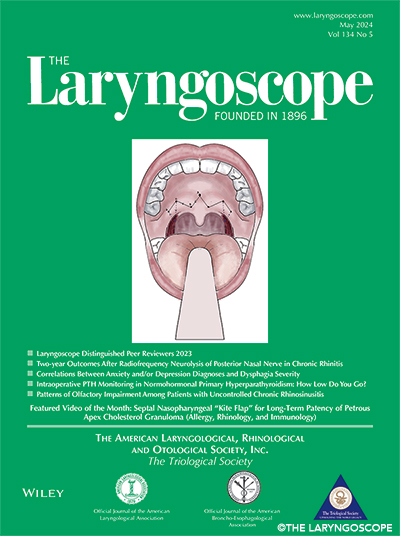 The Laryngoscope is the country’s oldest and largest otolaryngology peer-reviewed journal and has been the leading source of information on advances in the diagnosis and treatment of head and neck disorders since its launch in the late 19th century. Having a paper published in The Laryngoscope is a goal and point of pride for researchers in the field of otolaryngology.
The Laryngoscope is the country’s oldest and largest otolaryngology peer-reviewed journal and has been the leading source of information on advances in the diagnosis and treatment of head and neck disorders since its launch in the late 19th century. Having a paper published in The Laryngoscope is a goal and point of pride for researchers in the field of otolaryngology.
Explore This Issue
May 2024However, the journal’s popularity and selective nature mean that only a small portion of submissions will be selected for publication. What do The Laryngoscope editorial board and reviewers look for in a research paper, and how can you give your research the best chance of being accepted for publication?
The Laryngoscope’s Editor-in-Chief, Samuel H. Selesnick, MD, FACS, Professor and Vice Chair of Otolaryngology at Weill Cornell Medical College in New York City, sat down with ENTtoday to share insights from his tenure with the journal. He discussed the journal’s strengths, the acceptance and publication process, and what qualities make a good research paper. (This interview has been edited for length and clarity.)
ENTtoday: What makes The Laryngoscope different from other journals?
Dr. Selesnick: First of all, its size. It is the largest journal in terms of contributions to the literature in the field, but the quality of the accepted papers is the focus of the journal. With that, there’s a low acceptance rate for papers. The challenge is to publish more studies that meet the acceptance criteria. Ultimately, keeping the bar high in terms of quality benefits the readership of the journal in all areas including clinical, translational, and basic science research.
The publication process is not the work of an individual or even the executive leadership team. It’s really the work of the whole community, and the result is invaluable for the field of otolaryngology–head and neck surgery. — Samuel H. Selesnick, MD, FACS
That’s one of the reasons for our discussion today—I want to impart to potential authors what we think a quality manuscript looks like. Some aspects of quality have to do with the design of the study, and some are found in the writing of the manuscript.
ENTtoday: What are the different types of submissions accepted by The Laryngoscope?
Dr. Selesnick: The overwhelming majority of submissions are evidence-based clinical original research. We also publish systematic literature reviews, and a small number of case reports and “how I do it” articles. The literature reviews examine existing research, and through a structured and rigorous analytic process, can make conclusions based on a large number of studies. In 2023, we received 1,700 original report submissions, and 175 literature review submissions.
ENTtoday: Is there one type of article that gets rejected more than others?
Dr. Selesnick: Case reports and “how I do it” submissions must have an important message to be accepted by The Laryngoscope .
ENTtoday: What makes a good, high-quality paper?
Dr. Selesnick: Some of the things I’m going to mention may sound intuitive to clinical researchers, but it’s surprising how often the journal receives submissions that don’t follow basic tenets of quality research. To start with, the research question must be novel, relevant, and based on a hypothesis that attempts to answer a specific query.
ENTtoday: Is the biggest challenge that the research question lacks focus?
Dr. Selesnick: Yes, that is one of the bigger challenges. The importance of a good hypothesis can’t be overstated.
It’s surprising how often the journal receives submissions that don’t follow basic tenets of quality research. — Samuel H. Selesnick, MD, FACS